
->information about "soundsticker"
by benjamin bratton
temporal space capturing - time and space transforming
a signal – exposing information to ambient noise – exposing
coded noise to audible environment information 1
– imprinting spaces into an audio signal
1 noise as carrier
of information, noise as the opposite of information or anti-information
instructions:
record a soundfile to a soundsticker.
take the soundsticker to a place and play it.
record while it’s playing in this space and put this recording on
a new soundsticker. take the new soundsticker to a new place.
play it and record a new soundsticker
…
keep the last soundsticker.
record its sound to disc or/and play it for a special event.
the original audio signal – the message – is chosen.
the characteristics and quality of the sound are initially defined by the sound carrier – the soundsticker.
playing and recording the sound in a chosen space alters it in two ways,
through an addition as well as a filtering process:
the sound in the new environment is added to the original sound.


the placement of the soundsticker and recorder in the environment influences the intensity of filtering.
sound
how to find an adequate original audio signal?
the environment is full of sound, and that especially in the noisy2
city a lot of sounds are overheard3.
i chose to use human voices for the original sound because they represent
the human body in the audible world. i also chose the voices to say words,
because i wanted to have a clearly coded initial audio signal, a sound
that does not already have a lot of space imprinted in it. after this
sound has run through all the spaces, it will return again to be acknowledged
by humans who have provided the original signal.
the initial sound consists of 9 male and 6 female voices saying the words
“space” and “time”. it is 40 seconds long.
3 a mélange of sound without relevant information to us. this noise is pushed to the back of our consciousness, we don’t
consciously hear it.
space
how to find adequate displaying places.
option 1: make one recording a day in a space that occors worthy, chosing a different space and a different time every day.
option 2: ask every person who has contributed
to the sound to chose one location.
time and space gender studies
transforming space and time.
out in a bar late at night my working partner - in a rather “open”
state of mind - announced that he is space and i am time.
much later I found the following statement by hagbard celine 4:
“the man is space and the woman is time” said celine, “but
the universe itself is of course bisexual”.
knowing that my pal had never read anything about hagbard’s sayings,
I decided to take a look at the genders of space and time.
4 hagbard celine is a character in the book “masks of the illuminati” by robert anton wilson 1981.
| language | ||
| space | time | |
| english | - | - |
| german | m | f |
| french | f | m |
| italian | m | m |
| polish | m | m |
| spanish | m | m |
| portugese | m | m |
| arabic | m | m |
| finnish | - | - |
| hindi | m | f |
| japanese | - | - |
| kantonese | - | - |
| mandarin | - | - |
from 13 languages, 5 don't apply a gender to time and space.
in the left 8 languages the word space is male in 7 languages and female
in 1 language.
the word time is male in 6 languages and female in 2 languages.
it is obvious that the genders applied to the words time and space are
both mostly male. the exception are german and hindi (indogermanic languages).
they regard time to be female. and the only language in which space is
female is french.
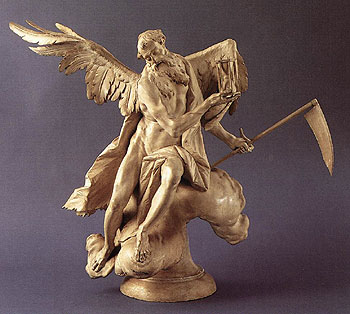
chronos, the greek god of time
chronos is time, a god who has never been underrated. for all-consuming
time, who for the human mind increases
endlessly, cannot in any way be separated from the orderly experience
of life, which is not conceivable without him.
therein lies the power of this god, who rules, not only the appearance
of things—making them look newer or older—, but also the soul,
who would not be capable of apprehending anything without his gifts. that
is why it has been said:
"ever-ageing time teaches all things." [prometheus 1 to hermes.
aeschylus, prometheus bound 982]
but there is no time for the mind that cannot remember. mnemosyne
made available to mortals the power to remember, a great faculty upon
which rest many others.

toth, the egyptian god of the moon, time, and measure
in ancient egyptian mythology, thoth was the god of the moon, god of
wisdom, the measurer of time, and the inventor of writing and numbers.
he is credited with devising the standard 365-day year.
in addition to being the god of the moon, the god of wisdom, and
the measurer of time, he was scribe, moralist, messenger, and supreme
magician. the
ancient egyptians credited him with inventing writing. he was the patron
god of all arts,
sciences, and intellectual pursuits. ancient egyptians believed that before
the dead could
enter the afterworld, their hearts were weighed against a feather of truth
to determine
whether they had led good and honest lives. in his role as scribe, thoth
recorded the
results of each judgment.
the god of infinity—”a supreme force or principle,…without ‘beginning or end…’…. all deities were aspects, attributes, or reflections” of coqui xee. he was also called pije xoo, or pijetao, as time, or its source, as he ruled over ”the thirteen gods of the zapotec sacred calendar.”
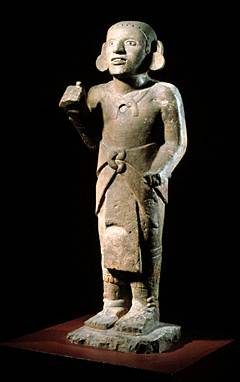
xiuhtecuhtl, aztec, the nahua, mexico
ometÈotlís omnipresence is an active principle of preservation, sustenance and maintained order as master of the universe. in ruling the heavens of the atmosphere and the clouds he was tlallichcatl; "the embodiment of wisdom and of the only truth on earth", he was personified as quetzalcoatl. xiuhtecuhtli was his name as "Lord of fire and of time". He was also called huehuetÈotl, "the old god".
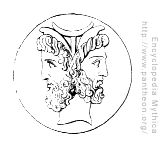
janus, roman
originally a solar god associated with the daybreak, and therefore with beginnings and initiative. an important deity in the roman pantheon. later he was considered the god of doorways, exits, and entrances, and gateways, both public and private. as god of beginnings he was also a god of time and invoked before all gods in prayers. he was depicted as having two faces so as to see forward and behind simultaneously. the month "january" was named after him.
the pre-existent primeval, hermaphroditic being "boundless time" the father/mother of ormazd and ahriman, the latter considered the first-born. the supreme god of the cult of zervanism generally considered a god of time and fate.
(the butterfly-winged female figures are personifications of time and the sun's cycles)
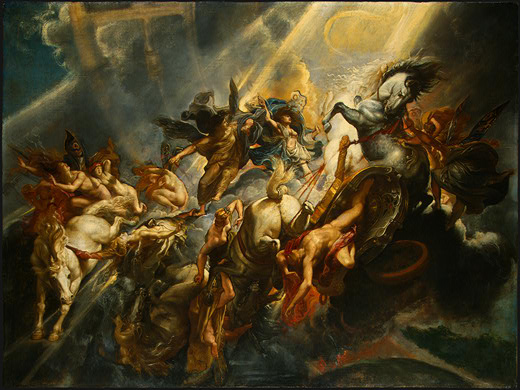
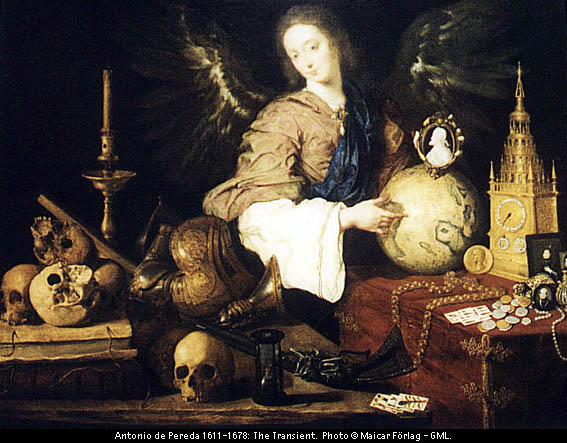
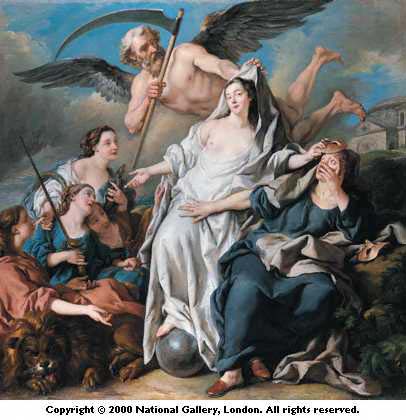
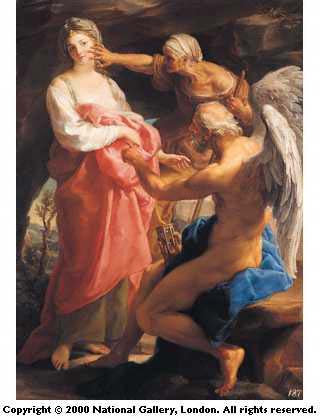

valevalenoa, the polynesian god of space
he is the son of tangaloa-the-explorer-of-lands and the queen of earth.
->http://www.samoa.co.uk/books/Samoa_100_Years/100_years_chapter1.html
god of space
an abstract god of space
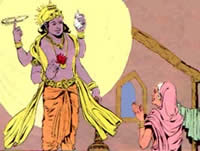
aditi, india
she ”is the cosmic origin of space itself.” she brings into being that which has been unmanifest out of the immensity of the vastness of space. aditi is the female principle which makes manifest divine truth. she is unlimited by time, is omnipresent, needing no vehicle as do the other gods. yet she is a personal deity, approachable, and the mother of the sky gods. ”in sanskrit, go means at once the cow and the ray. this double entendre of the word led the rishis to treat the physical cow as a symbol of light.” (she is not the physical cow but the cow of light).
”lady of the sphere of space,” one of the names of the goddess who is partner to vairocana.
with huh one of the initial primeval pairs, representing the infinity of space
i have found:
5 gods of time
1hermaphroditic god of time.
4 gods of space
2 goddesses of space
not just the genders of the words, but also the representations of time and space are primarily male. this is probably due to the fact that most civilizations on earth are patriarchal.
without having any examples from literature at this point, i may point
out that the moon often was connected to the woman in history, because
the female cycle is strongly dependent on the moon's cycle and of the
same duration. the moon is one of the oldest time-measuring instruments
of humans.
one could say that women, like the moon, are time measurers.
in this regard it is remarkable that even toth,
the egyptian god of the moon AND time AND measure is male.
this view on the whole topic could lead to an investigation about the
genders of the word moon in different languages...
unlike time, there is no greek god of space, meaning all space - earth,
matter, sky and the universe together. with many of the space-gods, it
is unclear what space they are in charge of.it could very well be that
they are gods of outer space, not all space.
but there are various personifications of the earth, sky and natural environments
(mountains, rivers etc.)
in many mythologies, space is a combination of the earth and sky (outer space). in the greek mythology gea is the earth and uranus the sky.
about the feminine conceptualization of nature in indian religious history:
http://ignca.nic.in/ps_05011.htm